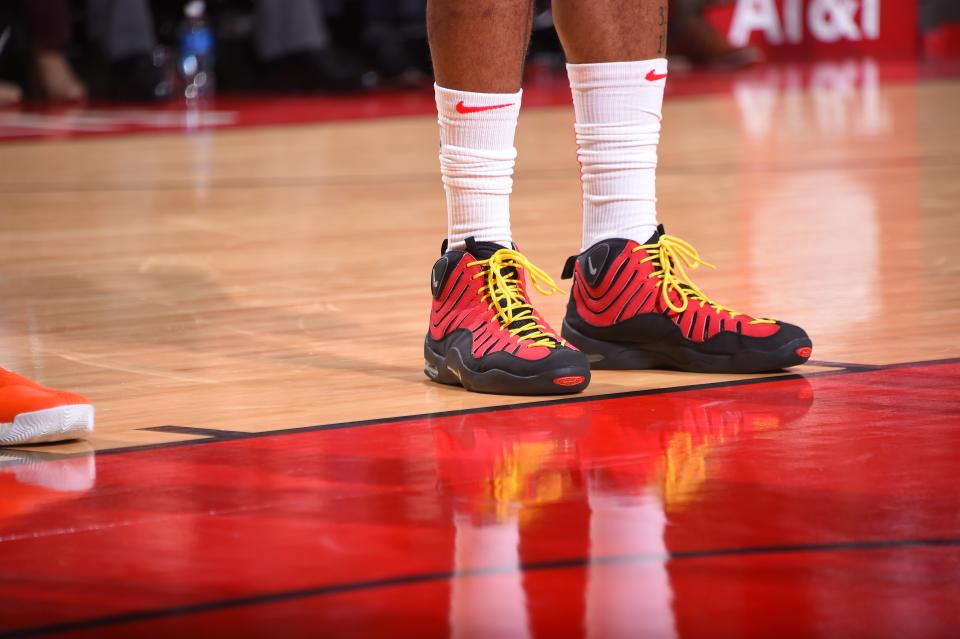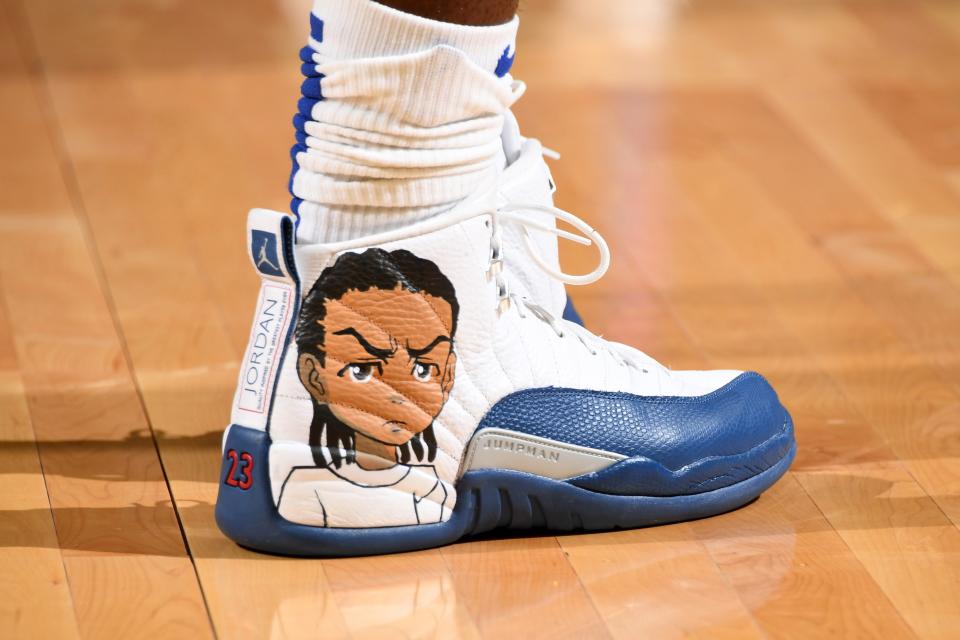The NBA's Sneaker Revolution Is Just Getting Started
Before the 2018 NBA season, the NBA decided to delete its on-court shoe color restriction. Their intent was seemingly pure: after the league’s current Nike deal began in 2017—where new themed jerseys and reconfigured visual identities flooded the league—the NBA let some of that energy pass on to the players. The decision was probably optics-informed, as team values and league revenues rose universally thanks to an astounding lucrative new TV deal, but in this case, everybody won.
The on-court result was immediate: more customs, more rare sneakers, more expressive and elaborate deployments of signature lines. What was black-and-white for 70-plus years suddenly snapped into color: it was like The Giver but for NBA kicks.
Now, though, we’ve reached a new, stranger point—one where where retro shoes like And 1’s Tai Chi, Reebok’s AI signature Questions, and the Vince Carter-popularized Shox BB4 are all on shelves again as coveted reissues. More will rise from the ashes, soon.
Sneakers
Boing.
When it comes to NBA sneaker culture... [30 for 30 voice:] What if I told you we were just getting started?
It turned out that on-court sneaker freedom kickstarted a much larger conversation throughout basketball culture, a possibly unintended result but a beautiful one. As the locker room tunnel runway became more and more of a pop culture concern, sneaker liberty became an entry point to larger personal marketing opportunities.
All of the sudden, there were multiple opportunities to showcase grails, as opposed to solely the on-court look. The feedback loop from locker room to court could be an endless one, a narrative in itself running alongside the storylines of the current NBA season.
Immediately, savvy players got creative and competitive, finding new ways to heighten their collections and to amplify that flex. Respected player/sneaker scholars like Houston Rockets forward P.J. Tucker and Los Angeles Lakers forward Kyle Kuzma became synonymous with the league’s sneaker culture, to the point that Kuzma signed on to be a brand ambassador for the sneaker reselling app GOAT, and Tucker parlayed his reputation into a breathless coverage of his collection and as a pillar of ESPN’s examination of the trend. Over the summer, the WNBA’s players dropped the mic, adding more competitive pressure to the tunnel moment than ever.

Oklahoma City Thunder v Houston Rockets
And now, in year two of the NBA sneakerssaince, the floodgates have fully opened. The vanguard is changing—at this point, new voices and perspectives are emerging, thanks to rookies like Tyler Herro, Bol Bol and Zion Williamson, all social media omnivores who can make needle-moving fashion decisions in real time. (Bol recently called out @LeagueFits for posting his “Summer League fits,” which is now the modern day equivalent of “We’re talking about practice!”) While players like Tucker and Kuzma positioned themselves to get the lion’s share of the media acclaim in the first year of the program, great work is being done at the margins, proving that there’s still room for even more innovative drip.
Now, the NBA sneaker conversation isn’t about who has the rarest shoes, or who can wear the Travis Scott Jordan 1s the most times. It’s about who has the deepest, most reverential collection, the one that works in styles and reference points from all over the basketball universe, and not just of a single brand’s make.
Take, for instance, Los Angeles Clipper center Montrezl Harrell—unlike Kuzma (Puma) and Tucker (Nike), Harrell is unbound by an umbrella apparel agreement, and he has one of the NBA’s great closets. Throughout last season, Harrell showcased a well-appointed, cheeky collection: one selection, a red-and-white Jordan 13, featured a custom Good Burger paint job. Another, a Jordan V custom, featured a screen playing the “To Live and Die in L.A.” video on a loop.

Los Angeles Clippers v Golden State Warriors
He also wore sneakers like the And1 Tai Chi, chunky ‘90s hoop shoes that immediately conjure that brand’s faceless man shouting insults via shirt. A revival of these sorts of sneakers was only a matter of time. Now as the drama heightens in the tunnel, the players’ competitive natures are kicking into overdrive.
More and more players—knowing they might not ever get a nod from adidas or Nike—have sought out other manufacturers to synthesize their visions, whether it’s bitcoin enthusiast/possible Batman villain Spencer Dinwiddie’s Project Dream collaboration K8IROS or D. Wade’s low-key-fire line with Li Ning.
The best news: there’s so much left to dust off. We haven’t seen a Starburys revival on an NBA court yet, for one. (Lou Williams’ signature sneaker with Chinese brand PEAK comes closest to sampling that energy.) While there’s been chatter about the return of Dada’s Spinners, they have yet to materialize—but there's a chance for style-conscious sneaker free agents like D'Angelo Russell to take sneaker choice into The Matrix
OK, I lied. There’s even better news: this is all about to escalate. The competition to make the locker room tunnel walk has never been more fierce, and the NBA is hungry to reel in casual fans with this narrative, because it’s arresting. Players like Tucker and Kuzma have made this walk a mainstream moment, the constellations are rapidly changing. The way a flannel hangs on OKC guard Shai Gilgeous-Alexander would make Cobain jealous. A new generation of drip gods lie in wait.
The current NBA season has already shown fans that the league’s basketball power balance is changing rapidly. But that tension has nothing on the shoe circuit, where mind-shattering work is mere moments away. PJ is still dusting off discontinued Nike lines. Cons are all the way back and All Stars are chopping up reissues straight off of the shelf. The best is yet to come.
Originally Appeared on GQ


